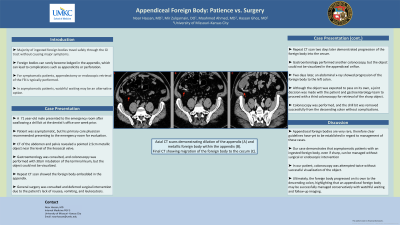Tuesday Poster Session
Category: General Endoscopy
P3430 - Appendiceal Foreign Body: Patience or Intervention?
Tuesday, October 24, 2023
10:30 AM - 4:00 PM PT
Location: Exhibit Hall

Has Audio

Noor Hassan, MD
University of Missouri-Kansas City
Kansas City, MO
Presenting Author(s)
Noor Hassan, MD1, Mir Zulqarnain, DO1, Mohamed Ahmed, MD2, Hassan Ghoz, MD1
1University of Missouri-Kansas City, Kansas City, MO; 2University of Missouri Kansas City, Overland Park, KS
Introduction: The majority of ingested foreign bodies (FB) travel safely through the gastrointestinal tract without causing any major symptoms. Rarely, FB become lodged in the appendix, which can lead to complications such as appendicitis or perforation. For symptomatic patients, appendectomy or endoscopic retrieval of the FB is typically performed. However, in asymptomatic patients, watchful waiting may be an alternative option. We present a rare case of a sharp FB stuck in the appendix which progressed through the gastrointestinal tract without intervention.
Case Description/Methods: A 71 year-old-male presented after swallowing a drill bit at the dentist’s office one week prior. The patient was asymptomatic, but his primary care physician recommended he present to the emergency room for evaluation. CT of the abdomen and pelvis revealed a pointed 2.5cm metallic object near the level of the ileocecal valve. Colonoscopy was performed with 30cm intubation of the terminal ileum, but the object could not be visualized. Repeat CT scan showed the foreign body embedded in the appendix. General surgery deferred surgical intervention due to the patient’s lack of abdominal pain, nausea, vomiting, and leukocytosis. CT scan two days later demonstrated progression of the FB to the cecum. Colonoscopy was performed again, but the object could not be visualized in the appendiceal orifice. Two days later, an abdominal x-ray showed that the FB had progressed to the left colon. Although the object was expected to pass on its own, a joint decision was made with the patient and the gastroenterology team to proceed with a third colonoscopy for retrieval of the sharp object. Colonoscopy was performed, and the drill bit was removed successfully from the descending colon without complications.
Discussion: Appendiceal foreign bodies are very rare, therefore clear guidelines have yet to be established in regard to management of these cases. Our case demonstrates that asymptomatic patients with an ingested FB, even if sharp, can be managed without surgical or endoscopic intervention. In our patient, colonoscopy was attempted twice, but the object could not be visualized. Ultimately, the FB progressed on its own to the descending colon, highlighting that an appendiceal FB may be successfully managed conservatively with time.

Disclosures:
Noor Hassan, MD1, Mir Zulqarnain, DO1, Mohamed Ahmed, MD2, Hassan Ghoz, MD1. P3430 - Appendiceal Foreign Body: Patience or Intervention?, ACG 2023 Annual Scientific Meeting Abstracts. Vancouver, BC, Canada: American College of Gastroenterology.
1University of Missouri-Kansas City, Kansas City, MO; 2University of Missouri Kansas City, Overland Park, KS
Introduction: The majority of ingested foreign bodies (FB) travel safely through the gastrointestinal tract without causing any major symptoms. Rarely, FB become lodged in the appendix, which can lead to complications such as appendicitis or perforation. For symptomatic patients, appendectomy or endoscopic retrieval of the FB is typically performed. However, in asymptomatic patients, watchful waiting may be an alternative option. We present a rare case of a sharp FB stuck in the appendix which progressed through the gastrointestinal tract without intervention.
Case Description/Methods: A 71 year-old-male presented after swallowing a drill bit at the dentist’s office one week prior. The patient was asymptomatic, but his primary care physician recommended he present to the emergency room for evaluation. CT of the abdomen and pelvis revealed a pointed 2.5cm metallic object near the level of the ileocecal valve. Colonoscopy was performed with 30cm intubation of the terminal ileum, but the object could not be visualized. Repeat CT scan showed the foreign body embedded in the appendix. General surgery deferred surgical intervention due to the patient’s lack of abdominal pain, nausea, vomiting, and leukocytosis. CT scan two days later demonstrated progression of the FB to the cecum. Colonoscopy was performed again, but the object could not be visualized in the appendiceal orifice. Two days later, an abdominal x-ray showed that the FB had progressed to the left colon. Although the object was expected to pass on its own, a joint decision was made with the patient and the gastroenterology team to proceed with a third colonoscopy for retrieval of the sharp object. Colonoscopy was performed, and the drill bit was removed successfully from the descending colon without complications.
Discussion: Appendiceal foreign bodies are very rare, therefore clear guidelines have yet to be established in regard to management of these cases. Our case demonstrates that asymptomatic patients with an ingested FB, even if sharp, can be managed without surgical or endoscopic intervention. In our patient, colonoscopy was attempted twice, but the object could not be visualized. Ultimately, the FB progressed on its own to the descending colon, highlighting that an appendiceal FB may be successfully managed conservatively with time.

Figure: Axial CT scans demonstrating dilation of the appendix (A) and metallic foreign body within the appendix (B). Final CT showing migration of the foreign body to the cecum (C).
Disclosures:
Noor Hassan indicated no relevant financial relationships.
Mir Zulqarnain indicated no relevant financial relationships.
Mohamed Ahmed indicated no relevant financial relationships.
Hassan Ghoz indicated no relevant financial relationships.
Noor Hassan, MD1, Mir Zulqarnain, DO1, Mohamed Ahmed, MD2, Hassan Ghoz, MD1. P3430 - Appendiceal Foreign Body: Patience or Intervention?, ACG 2023 Annual Scientific Meeting Abstracts. Vancouver, BC, Canada: American College of Gastroenterology.
